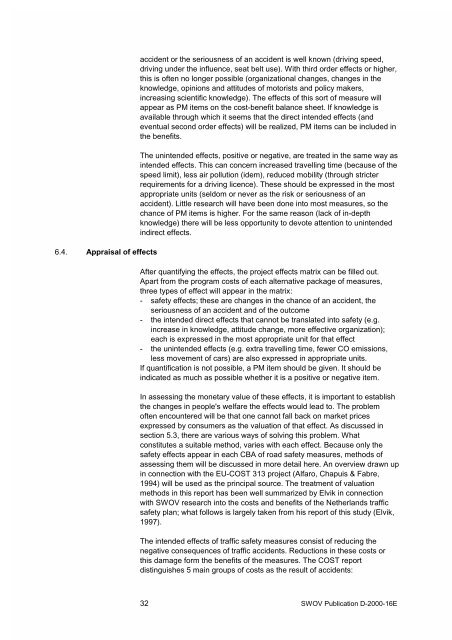Economic evaluation of road safety measures - Swov
Economic evaluation of road safety measures - Swov
Economic evaluation of road safety measures - Swov
Create successful ePaper yourself
Turn your PDF publications into a flip-book with our unique Google optimized e-Paper software.
6.4. Appraisal <strong>of</strong> effects<br />
accident or the seriousness <strong>of</strong> an accident is well known (driving speed,<br />
driving under the influence, seat belt use). With third order effects or higher,<br />
this is <strong>of</strong>ten no longer possible (organizational changes, changes in the<br />
knowledge, opinions and attitudes <strong>of</strong> motorists and policy makers,<br />
increasing scientific knowledge). The effects <strong>of</strong> this sort <strong>of</strong> measure will<br />
appear as PM items on the cost-benefit balance sheet. If knowledge is<br />
available through which it seems that the direct intended effects (and<br />
eventual second order effects) will be realized, PM items can be included in<br />
the benefits.<br />
The unintended effects, positive or negative, are treated in the same way as<br />
intended effects. This can concern increased travelling time (because <strong>of</strong> the<br />
speed limit), less air pollution (idem), reduced mobility (through stricter<br />
requirements for a driving licence). These should be expressed in the most<br />
appropriate units (seldom or never as the risk or seriousness <strong>of</strong> an<br />
accident). Little research will have been done into most <strong>measures</strong>, so the<br />
chance <strong>of</strong> PM items is higher. For the same reason (lack <strong>of</strong> in-depth<br />
knowledge) there will be less opportunity to devote attention to unintended<br />
indirect effects.<br />
After quantifying the effects, the project effects matrix can be filled out.<br />
Apart from the program costs <strong>of</strong> each alternative package <strong>of</strong> <strong>measures</strong>,<br />
three types <strong>of</strong> effect will appear in the matrix:<br />
- <strong>safety</strong> effects; these are changes in the chance <strong>of</strong> an accident, the<br />
seriousness <strong>of</strong> an accident and <strong>of</strong> the outcome<br />
- the intended direct effects that cannot be translated into <strong>safety</strong> (e.g.<br />
increase in knowledge, attitude change, more effective organization);<br />
each is expressed in the most appropriate unit for that effect<br />
- the unintended effects (e.g. extra travelling time, fewer CO emissions,<br />
less movement <strong>of</strong> cars) are also expressed in appropriate units.<br />
If quantification is not possible, a PM item should be given. It should be<br />
indicated as much as possible whether it is a positive or negative item.<br />
In assessing the monetary value <strong>of</strong> these effects, it is important to establish<br />
the changes in people's welfare the effects would lead to. The problem<br />
<strong>of</strong>ten encountered will be that one cannot fall back on market prices<br />
expressed by consumers as the valuation <strong>of</strong> that effect. As discussed in<br />
section 5.3, there are various ways <strong>of</strong> solving this problem. What<br />
constitutes a suitable method, varies with each effect. Because only the<br />
<strong>safety</strong> effects appear in each CBA <strong>of</strong> <strong>road</strong> <strong>safety</strong> <strong>measures</strong>, methods <strong>of</strong><br />
assessing them will be discussed in more detail here. An overview drawn up<br />
in connection with the EU-COST 313 project (Alfaro, Chapuis & Fabre,<br />
1994) will be used as the principal source. The treatment <strong>of</strong> valuation<br />
methods in this report has been well summarized by Elvik in connection<br />
with SWOV research into the costs and benefits <strong>of</strong> the Netherlands traffic<br />
<strong>safety</strong> plan; what follows is largely taken from his report <strong>of</strong> this study (Elvik,<br />
1997).<br />
The intended effects <strong>of</strong> traffic <strong>safety</strong> <strong>measures</strong> consist <strong>of</strong> reducing the<br />
negative consequences <strong>of</strong> traffic accidents. Reductions in these costs or<br />
this damage form the benefits <strong>of</strong> the <strong>measures</strong>. The COST report<br />
distinguishes 5 main groups <strong>of</strong> costs as the result <strong>of</strong> accidents:<br />
32 SWOV Publication D-2000-16E
















